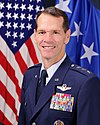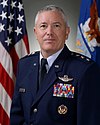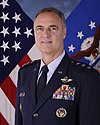First Air Force
| First Air Force (Air Forces Northern and Air Forces Space) | |
|---|---|
CMSgt Denny L. Richardson |
The First Air Force (Air Forces Northern & Air Forces Space; 1 AF-AFNORTH & AFSPACE) is a
It was one of the four original pre-
First Air Force is commanded by Lieutenant General Steven S. Nordhaus. Its Command Chief Master Sergeant is Chief Master Sgt. Denny L. Richardson.
It has the responsibility for ensuring the air sovereignty and air defense of the
With the transfer of responsibility for continental air defense from the active duty component of the Air Force to the
History
One of the four original numbered air forces, First Air Force was activated as the Northeast Air District of the
World War II

During the initial months after the
Beginning in May 1942, the mission of First Air Force became operational training of units and crews, and the replacement training of individuals for bombardment, fighter, and reconnaissance operations. It received graduates of
Air Defense Wings were also organized for the major metropolitan areas along the northeast coast, using training units attached to the Wings. By 1944 the likelihood of an air attack along the eastern seaboard was remote, and these air defense wings were reduced to paper units.
By 1944, the vast majority of the USAAF was engaged in combat operations in various parts of the world, such as the
Air Defense Command
In March 1946, USAAF Chief General
The command was originally assigned the region of the New England states, along with New York and New Jersey. With the inactivation of the ADC Eleventh Air Force on 1 July 1948 due to budget restrictions, command's region of responsibility was increased to include the upper Midwest states of Michigan and Ohio, along with the Mid-Atlantic region south to the North Carolina/Virginia Border.
In 1949
First Air Force was reactivated at
On 16 January 1968 Air Defense Command was re-designated Aerospace Defense Command (ADCOM) as part of a restructuring of USAF air defense forces. First Air Force's second period of service was short lived, however, and the command was again inactivated as the result of a major ADCOM reorganization on 31 December 1969 of the First, Fourth, Tenth Air Forces and several Air Divisions. This reorganization was the result of the need to eliminate intermediate levels of command in ADCOM driven by budget reductions and a perceived lessening of the need for continental air defense against attacking Soviet aircraft.
ADCOM reassigned the units under the inactivated First Air Force were reassigned primarily to the 20th, 21st or 23d Air Divisions.
Tactical Air Command
ADCOM was reorganized on 1 October 1979. The interceptors and warning radars were reassigned to Tactical Air Command (TAC). With this move many Air National Guard units that had an air defense mission also came under the control of TAC, which established a component called Air Defense, Tactical Air Command (ADTAC), at the level of a numbered air force.
On 6 December 1985 HQ USAF reactivated First Air Force at Langley Air Force Base, Virginia, and assigned it to Tactical Air Command (TAC), replacing ADTAC. First Air Force was given the mission to provide, train and equip combat ready air defence forces for the air defense of the North American continent.
Upon its reactivation, First Air Force was composed of units of the active Air Force and the Air National Guard. Because of its unique mission and its binational responsibilities, First Air Force works closely with the Canadian Forces. Canadian personnel are stationed at First Air Force Headquarters at Tyndall Air Force Base Florida, and at the various regional air defense sectors located throughout the United States.
Activation of the
- On 1 July 1987, four of the previous Air Defense CommandAir Defense sectors were reactivated, re-designated, assigned and co-located with the four remaining air divisions.
- The Montgomery Air Defense Sector (MOADS, Inactivated 1966) was reactivated as the 23d Air Division
- 23d Air Division inactivated 4 July 1987; assets transferred to SEADS.
- The Los Angeles Air Defense Sector (LAADS, Inactivated 1966) was reactivated as the Southwest Air Defense Sector (SWADS); assigned to 26th Air Division
- 26th Air Division inactivated 30 September 1990; assets transferred to SWADS.
- The Seattle Air Defense Sector (SEADS, Inactivated 1966) was reactivated as the Northwest Air Defense Sector (NWADS); assigned to 25th Air Division
- 25th Air Division inactivated 30 September 1990; assets transferred to NWADS.
- The New York Air Defense Sector (NYADS, Inactivated 1966) was reactivated as the Northeast Air Defense Sector (NEADS); assigned to 24th Air Division.
- 24th Air Division inactivated 30 September 1990; assets transferred to NEADS.
The Air Defense Sectors were transferred by the Air Force to the National Guard Bureau and allotted to the Air National Guard on 1 October 1990. They were operationally gained by First Air Force, Tactical Air Command.
- SEADS became part of the Tyndall AFB
- SWADS became part of the March AFB
- NWADS became part of the McChord AFB
- NEADS became part of the Griffiss AFB
First Air Force was transferred to Air Combat Command along with the rest of TAC on 1 June 1992.
Air Combat Command
In the years since its third activation, more of the responsibility for the defense of American air sovereignty has primarily shifted to the Air National Guard. Also, reorganization of the command structure of the U.S. Air Force saw the assignment of air defense to Tactical Air Command and later, its successor, Air Combat Command.
In the 1970s and 1980s, the role of the Air National Guard in the defense of North America increased. As this role changed, discussions between the active Air Force and the Air National Guard commenced concerning roles and responsibilities.
As the Cold War began to wind down and budgetary constraints became realities, more and more of the missions previously carried out by active duty forces began to be transferred into the reserve components. By the 1990s, 90 percent of the air defense mission was being handled by the Air National Guard.
In October 1997, First Air Force became primarily composed of Air National Guard units charged with the air defense of the North American continent. Today, First Air Force consists primarily of members of the Air National Guard. Its headquarters is located at Tyndall Air Force Base, Florida and it comprises 9 fighter wings, 1 composite wing with a fighter mission, and two air defense sectors for the Eastern and Western regions of the continental United States (CONUS).
Units circa 2022
- Griffiss AFB, Rome, New York
- McChord AFB), Washington
- Tyndall AFB, Florida
- Tyndall AFB, Florida
- Tyndall AFB, Florida
- 1 AF Detachment 1, Winnipeg, Manitoba, Canada
- Air Force Element, Joint Air Defense Operations Center (AFELM JADOC), JB Anacostia-Bolling (formerly Bolling AFB, District of Columbia
First Air Force also has
Additionally, First Air Force provides operational control of alert Air National Guard air defense fighter units and supporting non-flying units:
- F-15 Eagle
- Detachment 1, 104 FW, Langley AFB), Virginia
- F-16 Fighting Falcon
- F-15 Eagle
- Detachment 1 (OL-A), 125 FW, Homestead AFB), Florida
- F-16 Fighting Falcon
- Detachment 1, 138 FW, Ellington Field JRB, Texas
- F-15 Eagle
- F-15 Eagle
- Detachment 1, 144 FW, March AFB), California
- F-16 Fighting Falcon
- F-35 Lightning II
- F-15 Eagle
- F-16 Fighting Falcon
Non-flying units
- 101st Air and Space Operations Group (101 AOG), Tyndall AFB, Florida
- 101st Information Operations Flight (101 IOF), Salt Lake City IAP/ Roland R. Wright ANGB, Utah
- NAS Dallas), Garland, Texas
On July 15, 2021, First Air Force, now AFSPACE, assumed the operational command and control of the Human Space Flight Support (HSFS) mission, previously carried out by the Combined Force Space Component Command at Vandenberg Space Force Base, California.[5] This mission is executed by its assigned Detachment 3, First Air Force, based at Patrick Space Force Base, Florida.
Detachment 3, formerly commanded by Space Launch Delta 45, came under First Air Force control during a redesignation and change of command ceremony held at Cape Canaveral Space Force Station, Florida, that day. Air Force Lt. Gen. Kirk Pierce, commander, First Air Force, Continental U.S. NORAD Region, AFNORTH, and now AFSPACE, said First Air Force responsibilities now included '..to plan, train and execute worldwide rescue and recovery of NASA astronauts during contingency operations.'[5]
Lineage
- Established as Northeast Air District on 19 October 1940[1]
- Activated on 18 December 1940.
- Re-designated: 1 Air Force on 26 March 1941
- Re-designated: First Air Force on 18 September 1942
- Discontinued on 23 June 1958
- Activated on 20 January 1966
- Organized on 1 April 1966
- Inactivated on 31 December 1969
- Activated on 6 December 1985, assuming assets of Air Defense, Tactical Air Command (Inactivated)
- Re-designated First Air Force (ANG) on 1 October 1995
- Re-designated First Air Force (Air Forces Northern) on 1 November 2007.
Assignments
- General Headquarters Air Force(later, Air Force Combat Command), 18 Dec 1940
- Eastern Theater of Operations (later, Eastern Defense Command), 24 Dec 1941
- United States Army Air Forces, 17 Sep 1943
- Continental Air Forces, 16 Apr 1945
- Air Defense Command, 21 Mar 1946
- Continental Air Command, 1 Dec 1948 – 23 Jun 1958
- Air (later, Aerospace) Defense Command, 20 Jan 1966 – 31 Dec 1969
- Tactical Air Command, later Air Combat Command, 6 Dec 1985 onwards, at least until 24 March 2022.[1]
- Air Forces Space (AFSPACE, USAF contribution to United States Space Command), 3 May 2022 – present[5]
Major components
- 15th Tactical Reconnaissance Squadron: 3 February 1946.
- 1st Sea-Search Attack Group(Medium): November 1943-10 April 1944.
Commands
- 1 Air Force Service (later, 1 Air Force Base; 1 Base): 1 October 1941 – 13 May 1942
- 1 Air Support (later, I Air Support; I Ground Air Support) Command: 1 September 1941 – 17 August 1942
- 1 Bomber (later, I Bomber) Command: 5 September 1941 – 15 October 1942
- 1 Bomber Command: 24 August 1943 – 21 March 1946
- 1 Interceptor (later, I Interceptor; I Fighter) Command: 5 June 1941 – 21 March 1946
- XVI Air Force Service: 27 December 1946 – 1 April 1949
- XVII Air Force Service: 1 July 1948 – 23 February 1949
- XIX Air Force Service: 13 August 1948 – 23 February 1949.
Forces
- Air Forces Iceland: 6 December 1985 – 31 May 1993
Air Divisions
|
|
Districts
- 1 Air Reserve District: 1 Dec 1951 – 1 Apr 1954
Centers
- 1 Airborne Engineer Aviation Unit Training Center: 1 Apr 1943 – 10 Apr 1944
- Combined Air Defense Training Center: 4 Aug 1943 – 15 Jul 1944
- Eastern Signal Aviation Unit Training Center: 12 Mar 1943 – 12 Feb 1944
- USAF Air Defense Weapons Center: 6 Dec 1985 – 12 Sep 1991
- 601st Air and Space Operations Center: 1 Nov 2007 – present
- Air Force Rescue Coordination Center: 27 Apr 2007 – present
- Civil Air Patrol: 26 June 2016 – present
Sectors
- Northwest Air Defense Sector, 1 October 1990 – 31 December 1994
- Western Air Defense Sector, 1 January 1995–present
- Southeast Air Defense Sector, 1 October 1990 – 31 December 1994
- Southwest Air Defense Sector, 1 October 1990 – 31 December 1994
Wings and squadrons
- 551st Airborne Early Warning and Control Wing, 1 April 1966 – 4 December 1969
- 701st Air Operations Squadron, 1990 - 1 November 2007
Stations
- Mitchel Field, New York, 18 December 1940
- Fort Slocum (later, Slocum AFB), New York, 3 June 1946
- Mitchel AFB, New York, 17 October 1949 – 23 June 1958
- Stewart AFB, New York, 1 April 1966 – 31 December 1969
- Langley AFB, Virginia, 6 December 1985
- Tyndall AFB, Florida, 12 September 1991–present
List of commanders
| No. | Commander | Term | |||
|---|---|---|---|---|---|
| Portrait | Name | Took office | Left office | Term length | |
| 1 | Major General Henry C. Morrow | 1 November 2007 | 12 November 2009 | 2 years, 11 days | |
| 2 | Major General Garry C. Dean | 12 November 2009 | 31 August 2011 | 1 year, 292 days | |
| 3 | Lieutenant General Stanley E. Clarke III | 31 August 2011 | 7 March 2013 | 1 year, 188 days | |
| 4 | Lieutenant General William H. Etter | 7 March 2013 | 11 July 2016 | 3 years, 126 days | |
| 5 | Lieutenant General R. Scott Williams | 11 July 2016 | 20 June 2019 | 2 years, 344 days | |
| 6 | Lieutenant General Marc H. Sasseville | 20 June 2019 | 29 July 2020 | 1 year, 39 days | |
| 7 | Lieutenant General Kirk S. Pierce | 29 July 2020 | 31 March 2023 | 2 years, 245 days | |
| 8 | 31 March 2023 | Incumbent | 1 year, 18 days | ||
See also
References
![]() This article incorporates public domain material from the Air Force Historical Research Agency
This article incorporates public domain material from the Air Force Historical Research Agency
- ^ a b c d e "First Air Force (Air Forces Northern) (ACC)". Air Force Historical Research Agency. 24 March 2022.
- ^ a b "1st AF Mission". CONR-1AF (AFNORTH).
- ^ a b "Continental U.S. NORAD Region". CONR-1AF (AFNORTH).
- ^ "Biographies". www.1af.acc.af.mil. Retrieved 30 July 2020.
- ^ a b c d CONR-1AF 2022.
- ^ A Brief History of NORAD (PDF). North American Aerospace Defense Command Office of History. 2013. p. 41.
Sources
- CONR-1AF (13 May 2022). "First Air Force supports US Space Command as 'Air Forces Space'". Air Force. Retrieved 16 May 2022.
{{cite web}}: CS1 maint: numeric names: authors list (link) This article incorporates text from this source, which is in the public domain.
This article incorporates text from this source, which is in the public domain. - Maurer, Maurer (1983). Air Force Combat Units of World War II. Maxwell AFB, Alabama: Office of Air Force History. ISBN 0-89201-092-4.
- Ravenstein, Charles A. (1984). Air Force Combat Wings Lineage and Honors Histories 1947–1977. Maxwell AFB, Alabama: Office of Air Force History. ISBN 0-912799-12-9.
- A Handbook of Aerospace Defense Organization 1946 – 1980, by Lloyd H. Cornett and Mildred W. Johnson, Office of History, Aerospace Defense Center, Peterson Air Force Base, Colorado














